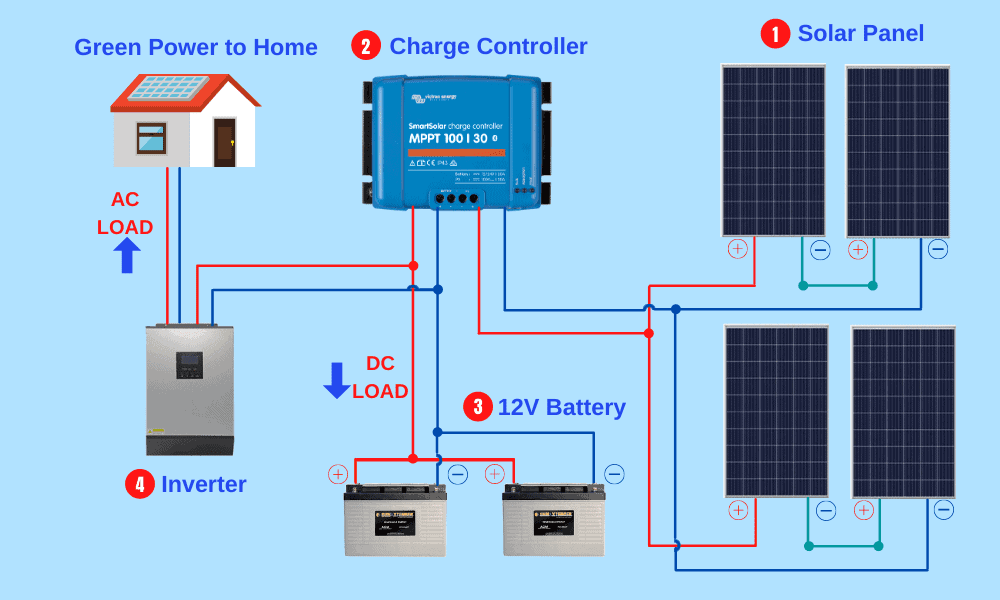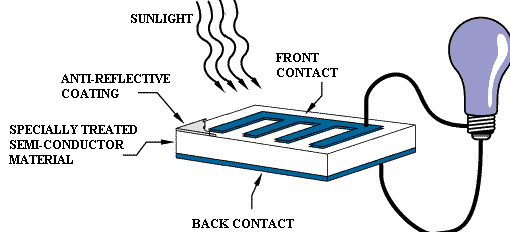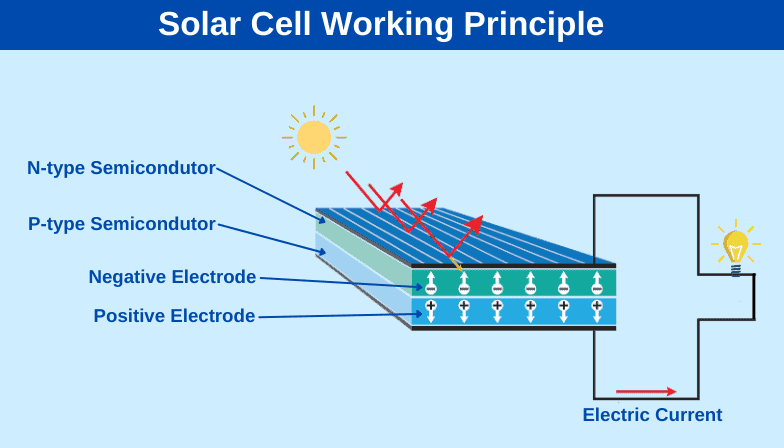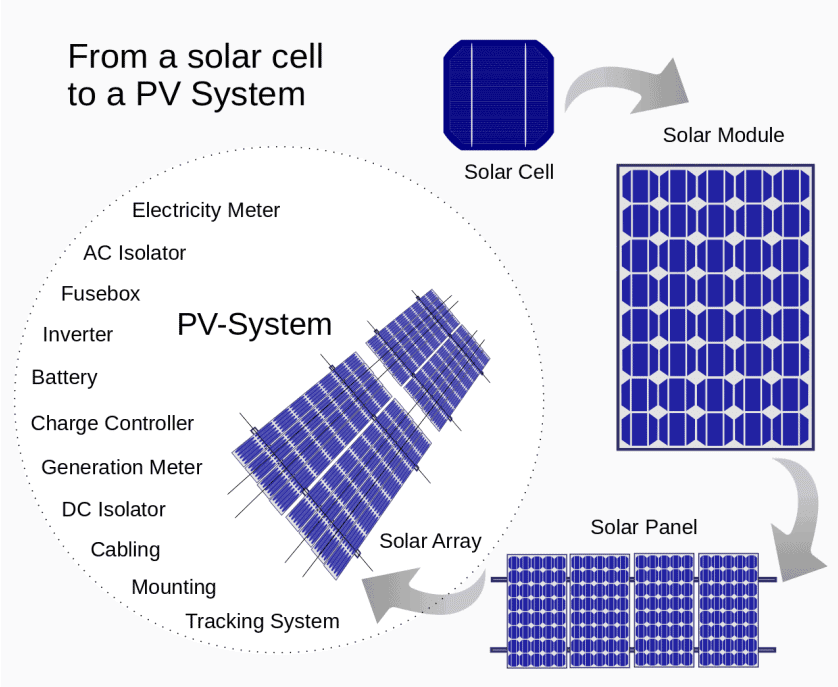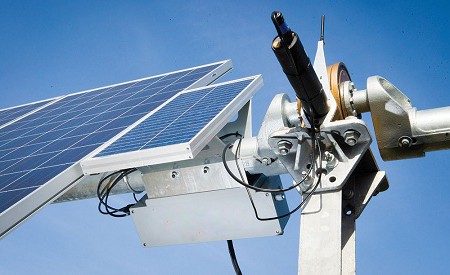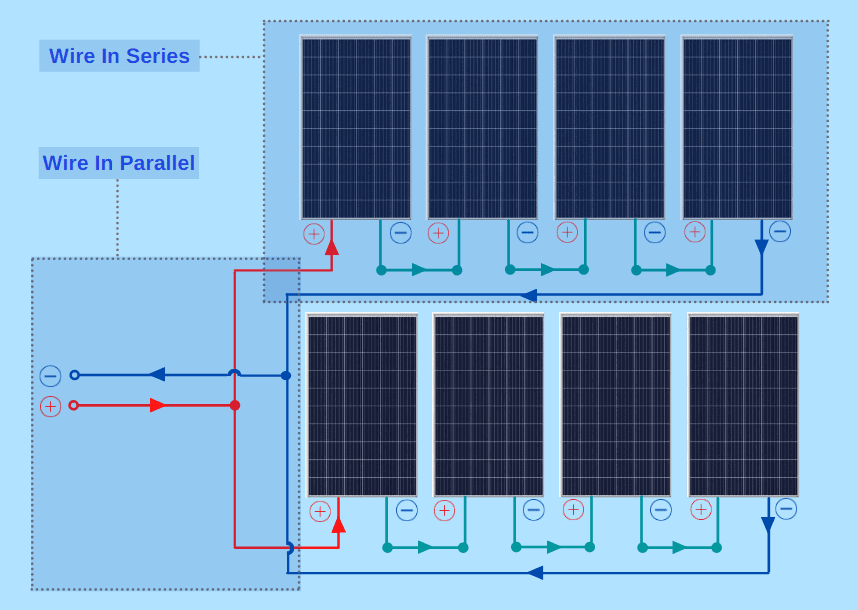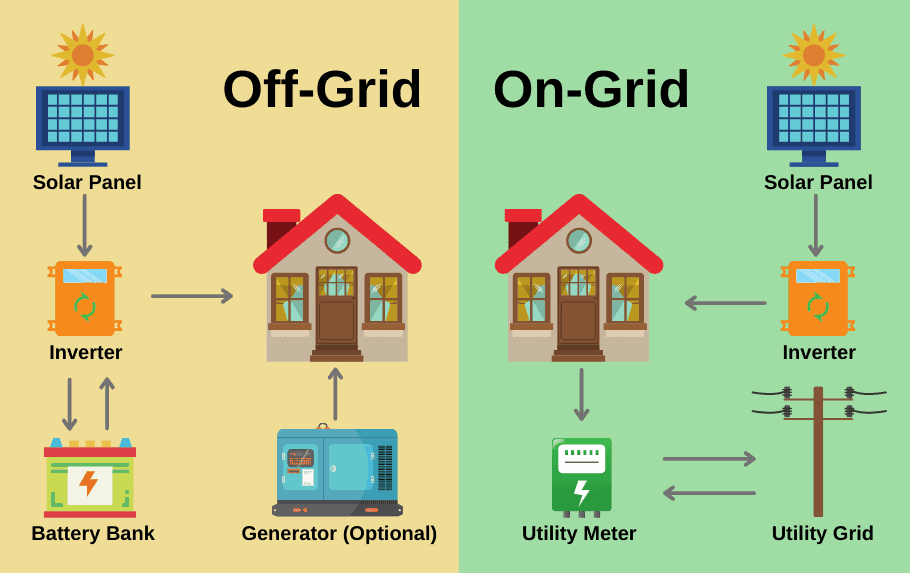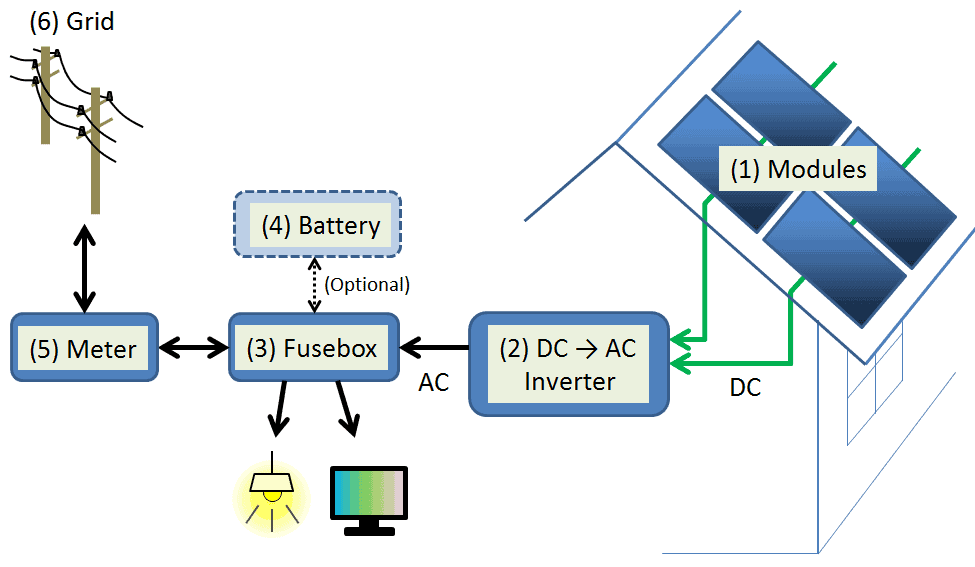If you are anything like me, then you find that a picture speaks a thousand words. I’ve learned all about how solar panels convert the sun’s light into electrical energy, but things only really fell into place when I saw it all laid out clearly in diagrams.
It’s great to have visual representations to help us to understand how scientific processes work. So I’m going to use some solar panel diagrams to show you how solar cells work and then describe all of the elements that go up to make a complete home solar system.
A basic solar cell
The diagram above shows the key elements in a solar cell. Solar cells collect energy from sunlight and convert it into electricity using a chemical reaction called the photovoltaic (PV) process.
Sunlight reaches our solar panel in the form of photons, small energetic particles/waves. These photons carry energy in the form of light, heat, and radiation, but it’s the light energy that a solar cell uses.
There is an anti-reflective coating on the front of a solar panel that protects the cell inside while allowing through as much light as possible. Glass is an excellent material for antireflective coatings, so solar panels are coated in strengthed laminated glass.
The inside of a solar cell contains a semiconductor material. Silicon is the semiconductor we use in home solar panels. A semiconductor is a material that is sometimes a good conductor of electricity and sometimes not. This changing conductivity is what we use to generate electricity.
When photons come into contact with the semiconducting silicon, they produce a flow of charge-bearing particles called electrons. The PV cell has a front contact with a cable attached and the back contact also connected by cable. In the diagram, you can see how the contrast in electrical charge between these two contacts creates a flow of electricity to power a light bulb.
How a photovoltaic cell works
The diagram above gives us a more detailed look at what happens inside a solar cell. The solar cell contains two separate discs of silicon sandwiched closely together. These silicon discs are doped or specially treated to give them an electrical charge.
The N-type silicon on the top level of the disc has an excess of electrons (negative charge), and the P-type silicon underneath has a deficiency of electrons (positive charge). The N-type silicon on the top level of the disc has a positive charge, and the P-type silicon underneath has a negative charge.
When no light is shining on a PV cell, the differently charged positive and negative discs of silicon create a barrier between each other, and electricity can’t flow between them.
But when photons from the sun hit the silicon discs, something special happens. When photons from the sun hit the silicon discs, they impart energy to the electrons in the P-type silicon, enabling them to move into the N-type layer. This movement of electrons creates an electrical current. This photoelectric effect is what produces electricity in a solar cell.
That’s how the process works. But if our home solar systems were made up only of solar cells, they wouldn’t be of much use since we wouldn’t be able to store or use the electricity we generate. We need several more elements to make up a complete home solar system.
The parts of a solar PV system
The diagram above is a good representation of the individual components that make up a home solar PV system. Let’s look at what all of these elements do and then see how everything connects.
Solar Cell to Solar Array
solar modules are sealed units that contain either sixty or seventy-two solar cells. These are carefully mounted and sealed to protect them from the elements and allow them to produce electricity for around twenty-five years. Several solar modules are connected to create a solar panel, and then several solar panels are connected to form a complete solar array.
Note that solar modules are more often called solar panels. Even though a solar panel is a collection of several solar cells, you will find that the term solar panel, or solar module, is often used interchangeably to describe a unit of several solar cells.
Tracking System (not essential)
one of the key goals when positioning a solar array is to ensure that it receives the maximum possible exposure to direct sunlight.
With most home solar systems, this simply involves angling the solar panels correctly and pointing them to the South in the northern hemisphere and the North in the southern hemisphere.
Solar tracking systems are a way to improve on this. They use various manual or automated systems to change the angle of the panels in a solar array so that they track the movement of the sun across the sky. Tracking systems increase the amount of time that solar panels are perpendicular to the sun and can dramatically increase the amount of electricity produced.
There is a drawback, though, because at the moment tracking systems are expensive, usually prohibitively so. The cost of the tracking system can be greater than the extra electricity generated, so few home systems use trackers. Solar tracking systems are an emerging technology with much promise for the future.
Mounting
the mounting of a solar array is simply the aluminum racking on which solar panels are mounted. On rooftop solar installations, this mounting usually cleaves a space between roof tiles and panels as temperature control to keep the panels cool.
Cabling
the different elements of a solar system are connected by cabling to transfer electricity. Cables are made from either copper or cheaper and less efficient aluminum. Because exterior cables are exposed to extremes of weather and temperature, their casing is made from special moisture and heat-resistant thermoplastic (THWN)
DC Isolator
A DC isolator is an important safety component of a home solar system. It is simply a switch that disconnects the solar array from the electricity network for servicing and maintenance.
Generation Meter
Generation meters show us how much electricity is being produced by the solar array. These provide valuable information that we can use to monitor the performance of our solar system and calculate precisely how much power our panels are generating.
Charge Controller (not essential)
We use a charge controller in solar systems that have battery storage. It monitors the current going into the batteries from the solar panels and ensures that the batteries don’t overcharge.
Battery (not essential)
Batteries are one of the ways that your home solar system stores the electricity it generates. Batteries are used in off-grid solar systems where they are the only storage mechanism for solar electricity. We charge the batteries with solar electricity and then use them to power devices in the home.
On-grid solar systems often don’t include batteries because the solar system connects to your main electricity supply. However, batteries can be added to provide backup power in case of grid outages. Electricity is transferred backward and forwards through this network connection so any excess electricity you generate is made available to the grid as a whole.
In hybrid solar systems, batteries are added to an on-grid connection to provide backup power in case of power outages.
Inverter
solar panels generate direct current DC electricity, but our homes use alternating current AC electricity. The inverter is where DC electricity is converted into AC electricity, making it compatible with the grid power supply and suitable for use in most household appliances.
Fuse Box
home solar systems, like all other home electrical systems, have a fuse box. This is a vital safety device where power surges or other problems trip a fuse, cutting power to the system and keeping it safe.
AC Isolator (not essential)
An AC isolator is a crucial safety element used only in grid-connected solar systems. It is a switch that you can turn off to isolate the AC power supply from the rest of the solar system for maintenance purposes.
Electricity Meter (not essential)
Your electricity meter connects to your home solar network in on-grid and hybrid solar systems. The meter monitors and records your electricity usage, the difference being that with your solar array connected, you are likely to see times when you’re giving more electricity into the system than you’re using and the meter will run backward.
How a home solar system comes together
Our last diagram provides a helpful summary of how all the components of a home solar system connect.
In the first stage of the process, we can see how our solar modules generate DC electricity. This DC electricity is cabled through to the second stage, where an inverter converts it into alternating current AC electricity.
After this conversion, the electricity is transferred through a fuse box for safety and then networked to our home appliances which receive power from the system.
In an off-grid system, the fuse box also connects to a battery which is where any extra electricity is stored and used to power the network at times when the sun isn’t generating electricity.
Things are different with an on-grid system where the fuse box connects through our electric meters to the power network, taking energy from the grid when solar production is low and giving it back when we have an excess.
Hopefully, these diagrams have given you a clearer understanding of how solar systems work and the individual elements that make them up. If you are considering solar energy for your home or business, it might be helpful to understand the pros and cons of solar energy. If you have any questions, comments, or suggestions, please share them with us below.

